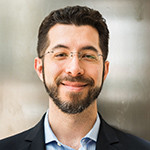
Duke Broadband: 13th Edition

Contents
From the Director

Welcome to this Special Issue of Broadband, the newsletter of the Fitzpatrick Institute for Photonics (FIP). As we celebrate the 15th anniversary of the institute in 2020, it is an opportune time to reflect on its achievements and contemplate its leap forward into the next decade.
With cross-disciplinary research at the center of its vision, and its faculty and staff as the foundation of its development, the FIP witnessed a continued growth trajectory for the last fifteen years. The institute has witnessed a strong, shared vision of interdisciplinary spirit among its faculty throughout the Duke campus as the growing collaborations testify to the vigor and relevancy of the exceptional efforts and enduring achievements of its faculty. The FIP faculty membership increased to over 140 with participation from over 40 departments and institutions ranging from engineering and physics to anesthesiology and art history.
- Read full letter
The interdisciplinary and collaborative spirit promoted by the FIP has allowed engineers, scientists and clinicians across the Duke campus to work closely together in developing and applying the most advanced light-based technologies to address the challenges of the 21st century in many areas ranging from advanced quantum computers and new materials to disease diagnostics and photo immunotherapy.
A highlight of our activities was the first FIP Virtual Symposium in 2020, with the keynote lecture presented by Dr. Donna Strickland, 2018 Nobel Laureate in Physics. The meeting was a celebration of the International Day of Light as proclaimed by UNESCO on May 16 in recognition of the important contribution of light-based technologies to society and humankind evolution throughout the history of science.
The meeting also celebrated the 60th anniversary of the discovery of laser with a presentation by Dr. John Dudley, chair of the UNESCO IDL steering committee. In May of 1960, Ted Maiman uncovered the first laser—a ruby laser, which is a small, handheld, low-powered device. Today, the laser is an essential part of our everyday lives, whether it is enabling rapid eye surgery, powering the global internet, scanning our groceries, or manufacturing our computer chips and smartphones.
The theme of the 2020 Symposium Special Topic was Photonics in the Era of Data Science: from Smart Sensing and Imaging to AI. The integration of sensing technologies and artificial intelligence (AI) is a transformational revolution in many fields. For example, in the medical field, the convergence of AI, smart sensors, robotics vision, virtual reality and digital technologies will enable real-time monitoring, interactive communication, instantaneous feedback and rapid intervention between patients, physicians, or health care providers, medical facilities and point-of-care needs. Indeed, we are witnessing a paradigm shift that will lead to a complete on-demand logistic solution for the delivery of health care throughout the course of their distribution between medical facilities and point-of-care.
The symposium was a reflection of the focus and initiative at FIP and at Duke, which is “bringing science and technology to the service of society.”
I invite you to browse our website to learn more about our faculty, research programs and activities.
I hope you have a successful, safe and enjoyable year.
Tuan Vo-Dinh
Director, Fitzpatrick Institute of Photonics
R. Eugene and Susie E. Goodson Professor of Biomedical Engineering
Professor of Chemistry
New Frontiers

Smartwatches vs COVID-19
Researchers launch a largescale effort called Covidentify to identify early biometric warning signs of COVID-19 infections using smartwatches
Featuring Jessilyn Dunn, Ryan Shaw, Chris Woods and Geoff Ginsburg

Artificial Organelles
Biomedical engineers use intrinsically disordered proteins to create artificial organelles that could help control cellular behavior
Featuring Ashutosh Chilkoti

AI IDs Superbugs
Machine learning algorithm uses high-temporal-resolution growth curves to identify pathogens and predict antibiotic resistance
Featuring Lingchong You

Modeling Metastasis
Supercomputer replicates blood flow and cancer cells to better understand how tumor cells attach to blood vessels to form new tumors
Featuring Amanda Randles

Accelerating Quantum Technologies
Duke joins a five-year project to ensure U.S. leadership in quantum R&D and accelerate the transfer of quantum technologies
Featuring Ken Brown, Jungsang Kim and Chris Monroe

Using Quantum Rules to Move Chemistry into Uncharted Territory
Center for Synthesizing Quantum Coherence uses ultra-fast lasers to design and control chemical reactions
Featuring David Beratan
New FIP Faculty

Al-Hafeez Dhalla
Assistant Research Professor of Biomedical Engineering
Faculty Network Member of the Duke Institute for Brain Sciences

Jessilyn Dunn
Assistant Professor of Biomedical Engineering and Biostatistics and Bioinformatics
Member in the Duke Clinical Research Institute

Sonia Grego
Associate Research Professor of Electrical and Computer Engineering
Founding Director of the Duke Smart Toilet Lab

Samira Musah
Assistant Professor of Biomedical Engineering and Medicine
Affiliate of the Regeneration Next Initiative
Member of the Duke Cancer Institute
2021 FIP Virtual Annual Meeting
May 16-18, 2021
Special Topics
Advanced Interferometry • Light Technologies and The Brain • Photonics and Pandemics
Keynote Speaker

Professor Rainer Weiss
Nobel Laureate in Physics 2017
Professor of Physics, Emeritus, Massachusetts Institute of Technology
Invited Lectures

Professor Ed Boyden
Y. Eva Tan Professor in Neurotechnology at MIT
Howard Hughes Medical Institute Departments of Brain and Cognitive Sciences, Media Arts and Sciences, and Biological Engineering
Co-Director, MIT Center for Neurobiological Engineering

Professor Christian J. Kähler
Institut für Strömungsmechanik und Aerodynamik, Universität der Bundeswehr München, Werner-Heisenberg-Weg, Neubiberg

Professor Jessica McIver
Department of Physics and Astronomy, The University of British Columbia, Vancouver

Professor Carl Petersen
Laboratory of Sensory Processing, Brain Mind Institute, Faculty of Life Science, Ecole Polytechnique Fédérale de Lausanne (EPFL)

Professor Na Ji
Associate Professor, Helen Wills Neuroscience Institute, Department of Physics, Department of Molecular Cell Biology, University of California, Berkeley
FIP 2020 Awardees

Vanessa Cupil-Garcia
Fitzpatrick Scholar
Fourth year PhD candidate, Chemistry

Tri Vu
Chambers Scholar
Third year PhD candidate, Biomedical Engineering

Haoran Zhang
Chambers Scholar
Second year PhD candidate, Biomedical Engineering

Alana Gonzales
Chambers Fellow
First year PhD student, Biomedical Engineering

Mingyu Kang
Chambers Fellow
First year PhD student, Physics

Kanghyun Kim
Chambers Fellow
First year PhD student, Biomedical Engineering

Steven Parker
Chambers Fellow
First year PhD student, Biomedical Engineering


